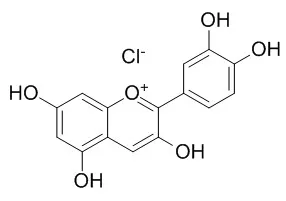| In vitro: |
| Biochem Pharmacol. 1996 Oct 11;52(7):1033-9. | | Inhibition of lipid peroxidation and the active oxygen radical scavenging effect of anthocyanin pigments isolated from Phaseolus vulgaris L.[Pubmed: 8831722] |
METHODS AND RESULTS:
No attention has been paid to anthocyanin pigments from the viewpoint of inhibitors of lipid peroxidation and scavengers of active oxygen radicals; therefore, we investigated the antioxidative, radical scavenging, and inhibitory effects on lipid peroxidation by UV light irradiation of three anthocyanin pigments, pelargonidin 3-O-beta-D-glucoside (P3G), cyanidin 3-O-beta-D-glucoside (C3G), and delphinidin 3-O-beta-D-glucoside (D3G), isolated from the Phaseolus vulgaris L. seed coat, and their aglycons, pelargonidin chloride (Pel), Cyanidin Chloride (Cy), and delphinidin chloride (Del).
CONCLUSIONS:
All pigments had strong antioxidative activity in a liposomal system and reduced the formation of malondialdehyde by UVB irradiation. On the other hand, the extent of antioxidative activity in a rat liver microsomal system and the scavenging effect of hydroxyl radicals (-OH) and superoxide anion radicals (O2-) were influenced by their own structures.
| | J Cell Physiol . 2018 Mar;233(3):2502-2512. | | Cyanidin Chloride inhibits ovariectomy-induced osteoporosis by suppressing RANKL-mediated osteoclastogenesis and associated signaling pathways[Pubmed: 28771720] | | Abstract
Over-production and activation of osteoclasts is a common feature of osteolytic conditions such as osteoporosis, tumor-associated osteolysis, and inflammatory bone erosion. Cyanidin Chloride, a subclass of anthocyanin, displays antioxidant and anti-carcinogenesis properties, but its role in osteoclastic bone resorption and osteoporosis is not well understood. In this study, we showed that Cyanidin Chloride inhibits osteoclast formation, hydroxyapatite resorption, and receptor activator of NF-κB ligand (RANKL)-induced osteoclast marker gene expression; including ctr, ctsk, and trap. Further investigation revealed that Cyanidin Chloride inhibits RANKL-induced NF-κB activation, suppresses the degradation of IκB-α and attenuates the phosphorylation of extracellular signal-regulated kinases (ERK). In addition, Cyanidin Chloride abrogated RANKL-induced calcium oscillations, the activation of nuclear factor of activated T cells calcineurin-dependent 1 (NFATc1), and the expression of c-Fos. Further, we showed that Cyanidin Chloride protects against ovariectomy-induced bone loss in vivo. Together our findings suggest that Cyanidin Chloride is capable of inhibiting osteoclast formation, hydroxyapatite resorption and RANKL-induced signal pathways in vitro and OVX-induced bone loss in vivo, and thus might have therapeutic potential for osteolytic diseases.
Keywords: Cyanidin Chloride; RANKL; bone resorption; osteoclast; osteolysis. |
|
| In vivo: |
| Planta Med. 2013 Nov;79(17):1599-604. | | Treatment of diabetes in the mouse model by delphinidin and cyanidin hydrochloride in free and liposomal forms.[Pubmed: 24108435] | Cyanidin Chloride and delphinidin are the main phenolic antioxidants in the grape (Vitis vinifera). The aim of this study was to investigate the in vitro and in vivo inhibitory effects of delphinidin and Cyanidin Chloride in the free and liposomal forms on the albumin glycation reaction.
METHODS AND RESULTS:
Delphinidin and Cyanidin Chlorides were encapsulated in the liposomes using an extrusion method. The rate of albumin glycation was evaluated using the ELISA method. Finally, in vivo anti-glycation of delphinidin and Cyanidin Chloride in the free and liposomal forms in diabetic mice was investigated. The encapsulation efficacies of delphinidin and Cyanidin Chloride in the liposomes were 89.05 % ± 0.18 and 85.00 % ± 0.15, respectively. In vitro treatment with 100 mg/mL delphinidin and Cyanidin Chloride in free forms could reduce the rate of albumin glycation to 30.50 ± 3.46 and 46.00 ± 2.50 %, respectively. Under identical conditions, the delphinidin and Cyanidin Chloride-loaded liposomes could reduce the rate of albumin glycation to 8.50 ± 2.10 and 14.60 ± 3.60 %, respectively. In vivo testing showed that anti-glycation activity of delphinidin and cyanidin in loaded forms was higher than in free forms. The daily administration of 100 mg/kg delphinidin chloride-loaded liposomes to diabetic mice at eight weeks could decrease the rate of albumin and HbA1c glycation to 46.35 ± 1.20 and 3.60 ± 0.25 %, respectively. Moreover, under identical conditions, the loaded liposomes with Cyanidin Chloride could decrease the rate of albumin and HbA1c glycation to 55.56 ± 1.32 and 4.95 ± 0.20 %, respectively.
CONCLUSIONS:
The findings showed that delphinidin and Cyanidin Chloride, in particular in the liposomal forms, could be used for treatment of diabetes mellitus complications. |
|






 Cell. 2018 Jan 11;172(1-2):249-261.e12. doi: 10.1016/j.cell.2017.12.019.IF=36.216(2019)
Cell. 2018 Jan 11;172(1-2):249-261.e12. doi: 10.1016/j.cell.2017.12.019.IF=36.216(2019) Cell Metab. 2020 Mar 3;31(3):534-548.e5. doi: 10.1016/j.cmet.2020.01.002.IF=22.415(2019)
Cell Metab. 2020 Mar 3;31(3):534-548.e5. doi: 10.1016/j.cmet.2020.01.002.IF=22.415(2019) Mol Cell. 2017 Nov 16;68(4):673-685.e6. doi: 10.1016/j.molcel.2017.10.022.IF=14.548(2019)
Mol Cell. 2017 Nov 16;68(4):673-685.e6. doi: 10.1016/j.molcel.2017.10.022.IF=14.548(2019)